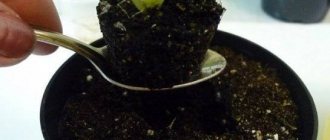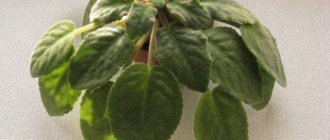Indoor plants are used to decorate a home or liven up the interior. Often these are violets. Saintpaulias, as botanists call them, are very beautiful, but vulnerable, requiring special care and increased attention. Diseases and pests that appear due to improper living conditions are considered especially dangerous. Diseases of violets can be determined by the appearance of the plant. The pattern of changes in the color and shape of leaves, flowers and root systems can indicate a specific problem. The list of infections and pests is huge, so sometimes it is difficult to determine the cause.
General characteristics of the plant
Violet has an attractive appearance. A small bush will not take up much space, and the flowering process will surprise you with its diversity. More detailed description of Saintpaulia:
- bush 10-15 cm high;
- the rosette consists of several tiers of green leaves that are fluffy to the touch;
- the frill of the plate is jagged, the color ranges from dark green to light green;
Sick violet
- leaf diameter can range from 2 cm to 10 cm;
- at the moment of flowering, a peduncle appears, at the top of which an inflorescence of several buds is formed;
- The color scheme of the buds can be varied. The shape, size and texture of the petals are individual for each variety.
During the development, growth and flowering process, various problems may appear. Usually this is a deterioration in the appearance of the plant. In extreme cases, the flower may even die. There are many reasons - diseases, infections, pests.
External characteristics of the plant
Why do violet leaves turn yellow?
Wick watering of violets - how to do it yourself
A problem arises with the above-ground part of the plant, in particular, the leaves change color. There are several reasons why violet leaves turn yellow:
- frequent watering;
- incorrectly selected substrate;
- lack of nutrients in the soil;
- inappropriate place to place the flowerpot;
- natural change of leaf cover;
- the need for replanting due to aging of the flower;
- leaves may lighten and then turn yellow - this is a sign of an incorrect degree of illumination.
The leaves have turned yellow
To correct the situation, it is enough to change the location of the flowerpot, replant, and normalize the watering regime.
Treatment options
By changes in its appearance, the violet signals its poor condition. If the leaves begin to dry around the edges, then there is a lack of compliance with the rules for caring for these delicate flowers . To help the plant and prevent its death, it is necessary to take measures to improve agricultural technology as soon as possible:
- adjust the watering regime. The frequency of watering should be selected depending on the time of year, room temperature and the individual characteristics of each plant. The problem with individual selection can be solved by using pots with automatic watering or switching plants to wick watering;
- water with soft water. Hard tap water should be left to stand for at least 24 hours. Flower growers living outside the city can use rain or melt water for irrigation;
- monitor air humidity. As necessary, the air should be humidified by possible means;
- Fertilize regularly. Depending on the season and growth phase, violets require different nutrients, macro and microelements. It is necessary to systematically fertilize or transplant plants into a new nutrient substrate.
Why do leaves curl inward?
The best varieties of violets - varieties with names
It happens that violet leaves curl for unknown reasons. This problem can cause the death of the flower. Why do violet leaves curl inward during the development of Saintpaulia:
- excess nutrients in the substrate;
- too frequent watering;
- pests that have settled under the leaf;
- incorrect transplantation of the sprout;
- inappropriate level of lighting.
The leaves are curling
In order for the leaf plate to stop deforming, you need to take a close look at the plant and adjust the maintenance conditions.
Pests on Uzambara violet plants
Pests that attack Saintpaulia can cause serious harm to indoor crops, since both the green parts of the plant and the roots fall into their sphere of interest. In addition, they spread the most famous diseases of violets.
At home, mites become the most dangerous pests of indoor plants. Cyclamen mites are especially common and harmful on violets; infestation with them is practically undetectable in the initial stages. Only when new leaves appear does it become obvious that the rosette is inhabited by microscopic insects, leading to the cessation of Saintpaulia growth, the refusal of the violet to bloom at home, and the shredding and curling of the leaves in the center of the rosette.
Leaves become covered with spots: reasons
Pots for violets - finding the perfect option
Sometimes spots of different colors appear on the plates, which can be located along the entire perimeter of the above-ground part of the plant. This appears very often in indoor specimens.
For your information! To understand the cause of the stains, you need to examine them through a magnifying glass. Sometimes Saintpaulia signals in this way to some external stimuli.
Spots on violet leaves can appear for many reasons:
- the plate may become covered with brown spots, which are the result of exposure to direct sunlight. These are burns;
- in those places where drops of water fall on the leaves, the surface may darken and then acquire a different color;
- if the pot is in a draft, dark formations will appear on the foliage.
Leaves with spots
Removing damaged parts can save the plant from imminent death.
Dangerous pests of Saintpaulia
Scale insects are dangerous because they deform violet leaves. Brown or red spots remain at the sites of their bites
. The female of this insect can be seen on an earthen coma, as if she is covered with transparent white fluff. Pests live in the folds and axils of leaves, on peduncles. If you find a shaggy louse on a violet, then you need to treat the flower with the following means:
- Phytofarm;
- Aktaroy;
- Actellicom.
For preventive purposes, when planting plants, you should put basadine in the pots.
.
Small thrips can also spoil violets. These white pests fall on the flower from brought plants or poplar fluff. They infect stamens and anthers, actively moving throughout the plant. To combat them, you can use Akarin, Vertimek, Agravertin and Dantop.
Quite often, Saintpaulias are affected by aphids, which are translucent insects of black, green or reddish hue. Aphids can be seen on viola growing points and leaves. Because of these pests, young shoots die. To get rid of them, the violet should be sprayed with a solution obtained from laundry or insecticidal soap. In addition, you can treat it with tobacco infusion or place lacewings or ladybugs on the flower. If there are too many aphid colonies on the plant, then it is better to use insecticides.
Violets are also attacked by different types of mites:
- Red spider. It leaves behind red spots surrounded by cobwebs, causing the leaves to change shape and dry out.
- Cyclamen. This pest can be seen on young leaves located in the middle of the rosette, leaving yellow dots on them.
- Cobwebby. This mite infects the outer leaves of violets, causing brown sunken spots to appear on them.
If these insects are detected, the flower should be treated with phytoverm, acarin or actellik.
What does it mean if violet leaves become limp?
A situation can become dangerous for the life of a flower when the stem begins to lose its elasticity, and the above-ground part of an indoor flower suddenly becomes sluggish. There may be several reasons for this decline:
- untreated sections have a fungal infection;
- serious mechanical damage;
- the appearance of pests that feed on Saintpaulia juice;
- incorrect temperature regime for the plant;
- diseases late blight and fusarium, which are characterized by rust-colored spots.
Note ! If the plant has recently been replanted, the cause may be burnt to the plant root by fertilizers added to the soil. In this case, it is impossible to save Saintpaulia.
The leaves have wilted
The question often arises when a violet has limp leaves, what to do to resuscitate the plant. The best solution would be transplantation. At the time of removing the sprout, all parts of the root and above-ground system can be examined. Remove the soft parts and transplant the rest of the seedling into a new container.
Why do the leaves become covered with a white coating like flour?
White bloom on violets is common, since the disease that affects the plant is very common. A coating appears on the leaves, which from a distance looks like flour sprinkled on greens. This is powdery mildew. Reasons for its appearance:
- high indoor humidity;
- incorrect temperature in the room;
- excessive watering;
- poor care of indoor flowers;
- the presence of infected plants within a radius of several meters. Even touching edges can transmit the disease to a healthy specimen.
Powdery mildew
Note! First, plaque covers the lower tiers, so it is sometimes difficult to identify the problem in time.
If the violet fades, what diseases could be the cause?
If first the leaves of the violet turn yellow, and then the whole bush begins to wither, then the problem may lie in improper watering, the location of the flowerpot, or fertilizing the soil. If there are no visible reasons for withering, then the cause may be a disease:
- fungus;
- rotting of the root system;
- bacteriosis;
- late blight;
- fusarium;
- gray rot.
It all depends on the primary state of the flower. The plant does not always die due to disease, since treatment can be carried out in time.
Brown spots due to lack of care
Even with the most careful and careful care, a finicky violet can get sick if the conditions of its maintenance are not particularly suitable. You should immediately respond to the signs of the disease and begin treatment. One of the reasons for this concern is the appearance of brown spots with a brown tint along the edge of the leaf. The flower tells you that the soil in the pot has begun to contain a lot of alkali and is no longer suitable for further use. In this case, the violet urgently needs a transplant.
You don't need any additional help; this task is easy to handle on your own. Buy a pot twice the size of the previous one, carefully remove the flower and try to clean the roots as best as possible from the old soil.
It is better to do this with a fork: carefully comb the root system from top to bottom, but try not to harm it. Old drainage is not suitable for new planting. Tear off all the leaves affected by the disease and sprinkle the wounds with charcoal. Saintpaulia will tell you what to do next after a successful transplant. Extra care will always come in handy.
Disease prevention measures and their treatment
In order not to bring the violet to a critical state, it is advisable to carry out periodic preventive maintenance. It is associated with the normalization of conditions for breeding Saintpaulia. You can get rid of diseases and pests by using special means for disinfecting the soil and the plants themselves.
Disease Prevention
The fight may involve simply replanting the specimen.
Bacteriosis
Yellowing and wilting of the plant can occur due to bacteriosis. The disease is quite common and can negatively affect the condition of the bush. Bacteria can rise from the soil that is in the pot. Sometimes germs come from other indoor plants. Treatment consists of normalizing plant care.
Powdery mildew
If the leaves begin to turn white, resembling a powder of flour, then signs of a fungal infection are showing. To prevent the appearance of powdery mildew, you need to wipe the flowerpot and tray, fluff the soil in the pot, and do not reduce the room temperature to 18 ° C.
If powdery mildew occurs on violets, how to deal with the problem at home? Treat the above-ground part of the plant with benlat or foundationol fungicide. At first, the fungal infection will become pale in color, and over time it will disappear completely.
Gray rot
In this case, the infection rises from the soil - there are spores of pathogenic fungi in the soil. To prevent microorganisms from becoming more active, it is necessary to carry out preventive measures: maintain normal temperature, humidity, and organize watering according to schedule.
Gray rot
As the disease develops, you can see a gray coating, rosettes extended from the center, which then begin to turn black. You need to calcinate or freeze the soil from the pot, treat the roots with a fungicide and replant the Saintpaulia.
Root rot
If the plant has raised a rosette with leaves up, then the problem is in the soil. If the soil loses acidity, there is a risk of root rot. During the development and growth of a fungal disease in the substrate, the disease rises higher, affecting the above-ground part.
To get rid of root rot, you need to transplant the Saintpaulia into another container with a new substrate. In addition, it is worth pre-trimming the damaged areas and rinsing the root in a special disinfectant solution.
Fungal diseases
Yellow, transparent and brown spots on violet leaves are a manifestation of fungal diseases that have affected the violet. Subsequently, secondary symptoms may occur: the stem and the rest of the above-ground part begin to dry out, then the plant dies and dies.
You need to carefully monitor the bush of your indoor plant. It is necessary to use special disinfectants and auxiliary substances. Any light spot should be carefully examined for the presence of parasites.
Fusarium
If watery spots appear on the edges of the leaves, then the plant is infected with a fungal spore of Fusarium. In this case, it is useless to treat Saintpaulia - the flower will die.
Important! In order not to infect other specimens, you need to throw away the pot along with the soil and the dead sprout.
Downy mildew
Downy mildew on violets appears almost the same as regular mildew. The only difference is the presence of brown and light green spots on the leaves and trunk of the plant. A false variant of the disease is treated in the same way as a standard problem.
Other diseases
Saintpaulias are very sensitive, therefore susceptible to various types of diseases. In addition, a bush with flowers can be affected by pests. These can be dust mites, spider mites, scale insects, and caterpillars.
Saintpaulias are very beautiful and elegant, but can deteriorate and fade over time. The reason for this is diseases and pests. Each disease has its own causes, but all of them are mainly associated with improper care and poor living conditions. Treatment is different in each case and requires an individual approach.
How to treat?
If all natural factors are in order (lighting, substrate, humidity, temperature), and signs of the disease are present, it is important to start fighting the fungus as quickly as possible. A sick violet must be isolated from healthy plants.
There are folk recipes for processing violets.
- Regular iodine, which is always in your home medicine cabinet, will help. Prepare a solution, take 3 milliliters of iodine per liter of water. Spray the plant with the resulting medicine.
- To remove powdery mildew from leaves, you need to do additional processing. For a liter of water you need to take 1 milliliter of liquid soap and a level teaspoon of table soda. Treat the surface of the affected leaves with this product.
- A solution made from whey in a ratio of 1 to 10 has proven itself to be beneficial.
It is necessary to spray diseased flowers three times a day every three days.
You can use drugs from the fungicide group:
- "Bayleton";
- “Topaz”, which, unlike all the substances presented, is safe for the health of people and pets;
- "Fundazol".
Toxic substances are used strictly following the instructions, always observing personal safety measures (gloves, respirator, goggles).
Before processing, flowers need to be prepared:
- remove all affected leaves and flowers;
- let the substrate dry, reducing watering for a while;
- place the pot of violets in a more illuminated place;
- adjust the temperature (air temperature not lower than 18 degrees);
- remove the top layer of the substrate, replacing it with a new one.
But it is better to completely replant the plant , since the old soil may contain spores.
After recovery, you need to keep the violet in quarantine for a couple of weeks and only then return it to its place.










